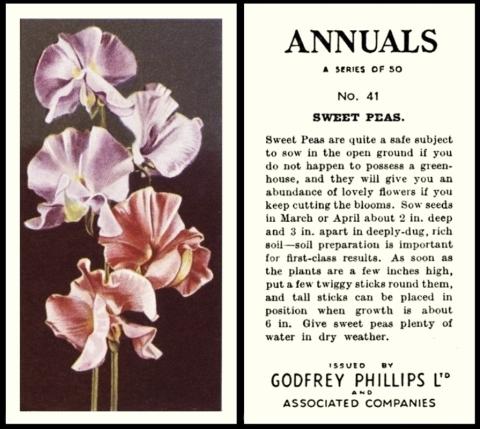
And lastly we have simply the title of the set, "Annuals", meaning, in our case, something that happens every year for a long period of time. Curiously, in the case of a flower, "Annual" means something rather different, for it is a plant that sprouts, flowers, goes to seed, and withers to nothing within just the space of one growing season - less than a year. And must be grown again from scratch in the following year.
This little plant is the sweet pea, or, to give its proper Latin name, Lathyrus odoratus - and as you might imagine the "odoratus" suggests that it has a scent, which all the best sweet peas do. They were first seen in the Mediterranean, Italy and Greece and their islands, and we are not sure how they made it to our shores.
What we do know is that it really only started to come into popular favour in this country in the 1880s, mostly as a result of changes effected by a Scottish man called Henry Eckford.
He was an estate gardener, and nurseryman, and because of that he was offered another job in the late 1870s, quite an unusual one, working in the gardens of an asylum near Cheltenham. The doctor in charge was a keen gardener and had also found, quite foresightedly for the time, that many of his patients responded positively to gardens, and time spent in nature. However he also had a bit of a hobby, and that was trying to improve on the flowers of the day by hybridising them to correct their failings. It appears that this enthusiasm was catching, and that somehow Mr. Eckford was introduced to the wonders of the humble sweet pea. We do not know why he chose that, but something must have appealed to him, and inspired him to start developing a better form, the original having rather small flowers, more or less hidden amidst a mass of tangled greenery, though the scent was always there.
In 1882 the asylum relocated to Shropshire and Mr. Eckford went too. In the same year he was awarded the Royal Horticultural Society`s First Class Certificate for one of his newly created plants, a cultivar called "Bronze Prince". This flower, for all the fanfare, has completely disappeared, leaving no plants, no seeds, and not even an image. We have no idea, therefore, of its size, or shape, or even, most tantalising of all, how bronze-like it was. This is especially intriguing as today, whilst there are species of sweet pea called "Bronze", they are towards the red end of the spectrum, whereas a true "Bronze" is a mixture of brown and yellow, and yellow is the one colour of sweet pea that everyone wants but nobody can produce. The closest is a cream colour, which, on some heads, darkens as it ages.
A few years later Mr. Eckford seems to have moved on, but stayed in Shropshire, and acquired some land on which he could set out long beds purely for sweet peas and experimenting with them. He produced over a hundred new forms and was awarded with a medal of honour by the Royal Horticultural Society. He died in 1906.
This is a charming set, with a twist, for it was issued twice. However you will never tell by looking at the fronts, which are identical, and never know from the backs unless you have both the versions.
All is revealed in our original reference book to the issues of Godfrey Phillips, RB.13, published in 1949, where the text reads :
9. ANNUALS. Small cards, size 67 x 37 m/m. Fronts printed by letterpress in colour. Backs in black , with descriptive text. Home and export issue, 1939. The New Zealand issue bears variations in the descriptive text to provide for planting the annuals 4-6 months later in the year than in the home issue, other export issues presumably have similar variations.
Now this is curious, because "other" export issues suggest that New Zealand was not the only recipient of an export set - and yet In our World Tobacco Issues Indexes the set is listed as :
ANNUALS . Sm. Nd. (50).
A. Home issue
B. New Zealand Issue, dates for planting 4-6 months later.
